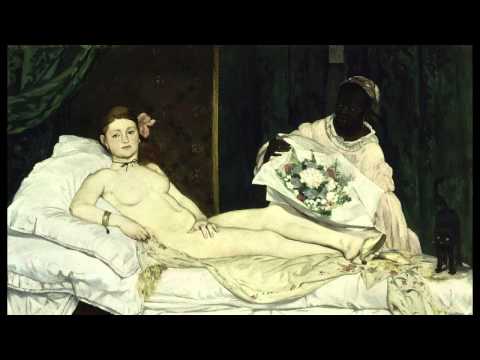11.40: Manet, Olympia
- Page ID
- 52589
Dr. Beth Harris and Dr. Steven Zucker provide a description, historical perspective, and analysis of Manet’s Olympia.
Édouard Manet, Olympia, 1863, oil on canvas, 130.5 cm × 190 cm (51.4 in × 74.8 in), (Musée d’Orsay, Paris).
Édouard Manet brought to Realism his curiosity about social mores. However, he was not interested in mirroring polite parlor conversations and middle class promenades in the Bois de Boulogne (Paris’ Central Park). Rather, Manet invented subjects that set the Parisians’ teeth on edge.
In 1865, Manet submitted his risqué painting of a courtesan greeting her client (in this case, you), Olympia, of 1863, to the French Salon. The jury for the 1865 Salon accepted this painting despite their disapproval of the subject matter, because two years earlier, Manet’s Luncheon on the Grass created such a stir when it was rejected from the Salon. (It was instead exhibited in Emperor Napoleon III’s conciliatory exhibition—the Salon des Réfusés, or the Exhibition of the Refused. Crowds came to the Salon des Réfusés specifically to laugh and jeer at what they considered Manet’s folly.)
Somehow they were afraid another rejection would seem like a personal attack on Manet himself. The reasoning was odd, but the result was the same—Olympia became infamous and the painting had to be hung very high to protect it from physical attacks.
Manet was a Realist, but sometimes his “real” situations shocked and rocked the Parisian art world to its foundations. His later work was much tamer.
Contributors
- Manet, Olympia. Authored by: Dr. Beth Harris and Dr. Steven Zucker; Text by Dr. Beth Gersh-Nesic. Provided by: Khan Academy. Located at: www.khanacademy.org/humanities/becoming-modern/avant-garde-france/realism/v/manet-olympia-1863-exhibited-1865. License: CC BY-NC-SA: Attribution-NonCommercial-ShareAlike


